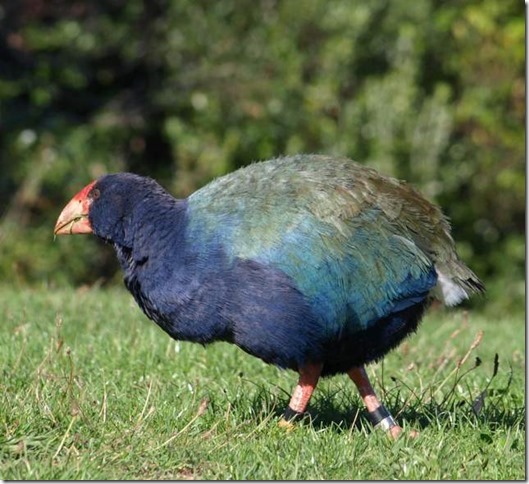Tiritiri Matangi

VulcanSpirit
Richard & Alison Brunstrom
Wed 25 Jun 2014 14:52
|
Our maintenance work completed, the expanded crew set off to the nearly
adjacent conservation island of Tiritiri Matangi for a spot of well-earned
R&R. This small island near Auckland was one of NZ’s first attempts at
regeneration for conservation purposes. Until 40 years ago the island was a
farm, with short baked turf and scarcely a native plant to be seen. Nowadays it
is lush semitropical forest and has an amazing range of reintroduced birds. The
main reason for our visit was to see takahe Porphyrio mantelli living
almost in the wild (they’re flightless, so can’t escape the island, but are
otherwise entirely free).
There used to be two species of takahe, one on each main island. The
northern one went extinct before Europeans arrived, and the southern one was
believed to have gone too, until a small population was miraculously
rediscovered in a remote area of Fiordland in 1948. The NZ DoC has transferred a
few birds to a number of islands, one of them being Tiritiri, where they are
very slowly increasing in numbers and providing a degree of insurance for the
survival of the species. They are still incredibly rare, with a total population
of only around 400 birds.
Takahe are the world’s largest rail, weighing in at a hefty 3kg or so, and
are about the size of a turkey. They tell a particularly interesting story about
evolution. Their ancestors are believed to have flown to NZ about 5m years ago
and subsequently lost the ability to fly due to lack of predation – flying uses
lots of energy so is pointless unless it confers a survival benefit. Here is a
chunky takahe looking resplendently iridescent in the morning sun on the grass
outside the visitor centre:
 One of the most interesting things about the taklahe is that its ancestor
is believed to have been the swamp hen Porphyrio porphyrio which lives
around the southern hemisphere. It is believed to have reached NZ twice, once
about 5m years ago and evolving locally into the takahe, and then a second time
much more recently. At Tiritiri you can see the two birds side by side for a
comparison of evolution in action, in this case with the heavy flightless takahe
on the right and the much sleeker but very obviously closely related pukeko on
the left:
 Tiritiri is marvellous for other birds too, and the woods are alive with
song, unlike most of NZ’s forests which are tragically silent. Here is another
rarity, the red crowned parakeet/kakariki Cyanoramphus novaezelandiae
sitting on a flax flowerhead:
 NZ has a number of parrots as has previously been noted in this blog. All
seem to have arrived fairly recently from Australia where there is a bewildering
array from budgerigars to cockatoos. I expect that dedicated Blog readers will
be subjected to more pretty bird pictures in due course (count on it –
Ed.) |